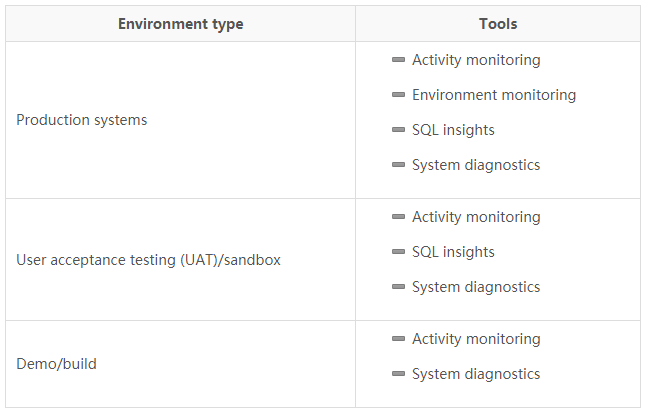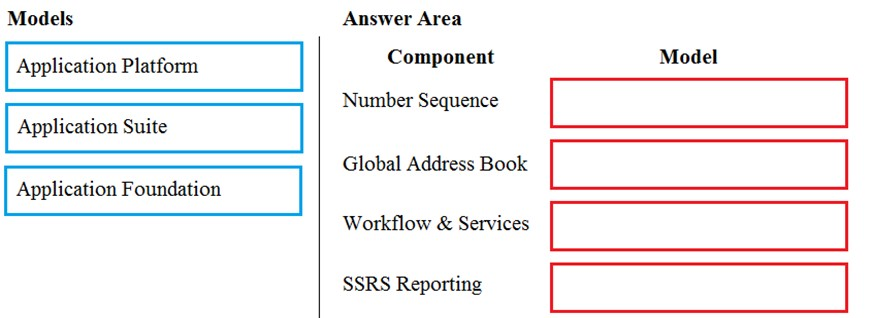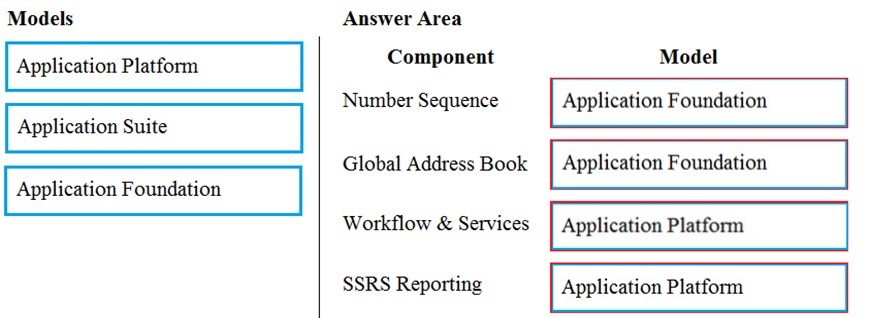Microsoft MB-500 Exam Practice Questions (P. 3)
- Full Access (299 questions)
- Six months of Premium Access
- Access to one million comments
- Seamless ChatGPT Integration
- Ability to download PDF files
- Anki Flashcard files for revision
- No Captcha & No AdSense
- Advanced Exam Configuration
Question #11
DRAG DROP -
You are a Dynamics 365 Finance developer.
You need to troubleshoot performance issues for a client.
Which Lifecycle Services (LCS) tools should you use for each environment? To answer, drag the appropriate environment types to the correct tools. Each environment type may be used once, more than once, or not at all. You may need to drag the split bar between panes scroll to view content.
NOTE: Each correct selection is worth one point.
Select and Place:

You are a Dynamics 365 Finance developer.
You need to troubleshoot performance issues for a client.
Which Lifecycle Services (LCS) tools should you use for each environment? To answer, drag the appropriate environment types to the correct tools. Each environment type may be used once, more than once, or not at all. You may need to drag the split bar between panes scroll to view content.
NOTE: Each correct selection is worth one point.
Select and Place:

Correct Answer:

Box 1: User Acceptance Testing (UAT) and Build
Box 2: User Acceptance Testing (UAT) Only
Not all environments contain all the tools. The following table shows the tools that are available for each type of environment.

Box 3: Build only -
Reference:
http://axhelper.com/?p=16527

Box 1: User Acceptance Testing (UAT) and Build
Box 2: User Acceptance Testing (UAT) Only
Not all environments contain all the tools. The following table shows the tools that are available for each type of environment.

Box 3: Build only -
Reference:
http://axhelper.com/?p=16527
send
light_mode
delete
Question #12
You are a Dynamics 365 Finance developer. You have two tables as shown in the following exhibit:

You need to configure Table1 to ensure that records cannot be deleted from Table1 if Table2 contains related records.
Which value should you use for the OnDelete property?

You need to configure Table1 to ensure that records cannot be deleted from Table1 if Table2 contains related records.
Which value should you use for the OnDelete property?
- ANone
- BCascade
- CCascade + Restricted
- DRestrictedMost Voted
Correct Answer:
D
Example of Restricted -
Suppose we have two tables (Customer & Order) and the relation is of One-To-Many i.e Customer can have many orders.
So on a parent table i.e.(Customer) if I set a delete action property to ג€RESTRICTEDג€ for Order table. Then If I go and delete the record from a Customer table. It will first check the record in the child table and if exist that warning prompt saying that first we need to delete a record from child table.
Incorrect Answers:
B: Example of Cascade:
Suppose we have two tables (Customer & Order) and the relation is of One-To-Many i.e. Customer can have many orders.
So on a parent table i.e.(Customer) if I set a delete action property to ג€CASCADEג€ for Order table. Then If I go and delete the record from a Customer table. It will also delete all the related records in Order table automatically.
C: Example of Cascade + Restricted
Suppose we have three tables (Person ,Customer & Order) Now Person is a parent of Customer table, and Customer is a parent of Order table having (One-To-
Many) relations -
If I set a Delete action property on Person table to ג€CASCADEג€ for customer table and If I set a Delete Action property on a CUSTOMER table for Order table to
ג€CASCADE +RESTRICTEDג€.
So if I delete a record from Customer table then It will first check the record in the child table(order table) and if exist that warning prompt saying that first we need to delete a record from child table.
But if I delete a record from Person table it will automatically delete a record in Customer table and all records related to customer table in Order table would also be deleted.
Reference:
https://amazingax.wordpress.com/2013/01/13/microsoft-dynamics-ax-2012example-of-cascaderestricted-and-cascade-restricted-delete-action-property-for-a- table-relation/
D
Example of Restricted -
Suppose we have two tables (Customer & Order) and the relation is of One-To-Many i.e Customer can have many orders.
So on a parent table i.e.(Customer) if I set a delete action property to ג€RESTRICTEDג€ for Order table. Then If I go and delete the record from a Customer table. It will first check the record in the child table and if exist that warning prompt saying that first we need to delete a record from child table.
Incorrect Answers:
B: Example of Cascade:
Suppose we have two tables (Customer & Order) and the relation is of One-To-Many i.e. Customer can have many orders.
So on a parent table i.e.(Customer) if I set a delete action property to ג€CASCADEג€ for Order table. Then If I go and delete the record from a Customer table. It will also delete all the related records in Order table automatically.
C: Example of Cascade + Restricted
Suppose we have three tables (Person ,Customer & Order) Now Person is a parent of Customer table, and Customer is a parent of Order table having (One-To-
Many) relations -
If I set a Delete action property on Person table to ג€CASCADEג€ for customer table and If I set a Delete Action property on a CUSTOMER table for Order table to
ג€CASCADE +RESTRICTEDג€.
So if I delete a record from Customer table then It will first check the record in the child table(order table) and if exist that warning prompt saying that first we need to delete a record from child table.
But if I delete a record from Person table it will automatically delete a record in Customer table and all records related to customer table in Order table would also be deleted.
Reference:
https://amazingax.wordpress.com/2013/01/13/microsoft-dynamics-ax-2012example-of-cascaderestricted-and-cascade-restricted-delete-action-property-for-a- table-relation/
send
light_mode
delete
Question #13
Note: This question is part of a series of questions that present the same scenario. Each question in the series contains a unique solution that might meet the stated goals. Some question sets might have more than one correct solution, while others might not have a correct solution.
After you answer a question in this section, you will NOT be able to return to it. As a result, these questions will not appear in the review screen.
You create a new form in a project.
You need to display tabs in a vertical alignment.
Solution: Apply the Simple List pattern.
Does the solution meet the goal?
After you answer a question in this section, you will NOT be able to return to it. As a result, these questions will not appear in the review screen.
You create a new form in a project.
You need to display tabs in a vertical alignment.
Solution: Apply the Simple List pattern.
Does the solution meet the goal?
- AYes
- BNoMost Voted
Correct Answer:
A
Reference:
https://docs.microsoft.com/sv-se/dynamics365/fin-ops-core/dev-itpro/user-interface/simple-list-details-form-pattern
A
Reference:
https://docs.microsoft.com/sv-se/dynamics365/fin-ops-core/dev-itpro/user-interface/simple-list-details-form-pattern
send
light_mode
delete
Question #14
DRAG DROP -
You need to map the Dynamics 365 Finance components into the standard models.
Which component belongs to which model? To answer, drag the appropriate models to the correct components. Each model may be used once, more than once, or not at all. You may need to drag the split bar between panes or scroll to view content.
NOTE: Each correct selection is worth one point.
Select and Place:

You need to map the Dynamics 365 Finance components into the standard models.
Which component belongs to which model? To answer, drag the appropriate models to the correct components. Each model may be used once, more than once, or not at all. You may need to drag the split bar between panes or scroll to view content.
NOTE: Each correct selection is worth one point.
Select and Place:

Correct Answer:

Reference:
https://docs.microsoft.com/en-us/dynamics365/fin-ops-core/dev-itpro/dev-tools/application-stack-server-architecture

Reference:
https://docs.microsoft.com/en-us/dynamics365/fin-ops-core/dev-itpro/dev-tools/application-stack-server-architecture
send
light_mode
delete
Question #15
Note: This question is part of a series of questions that present the same scenario. Each question in the series contains a unique solution that might meet the stated goals. Some question sets might have more than one correct solution, while others might not have a correct solution.
After you answer a question in this section, you will NOT be able to return to it. As a result, these questions will not appear in the review screen.
You create a new form in a project.
You need to display tabs in a vertical alignment.
Solution: Apply the Table of Contents pattern.
Does the solution meet the goal?
After you answer a question in this section, you will NOT be able to return to it. As a result, these questions will not appear in the review screen.
You create a new form in a project.
You need to display tabs in a vertical alignment.
Solution: Apply the Table of Contents pattern.
Does the solution meet the goal?
- AYesMost Voted
- BNo
Correct Answer:
B
Reference:
https://docs.microsoft.com/en-us/dynamics365/fin-ops-core/dev-itpro/user-interface/table-of-contents-form-pattern
B
Reference:
https://docs.microsoft.com/en-us/dynamics365/fin-ops-core/dev-itpro/user-interface/table-of-contents-form-pattern
send
light_mode
delete
All Pages
